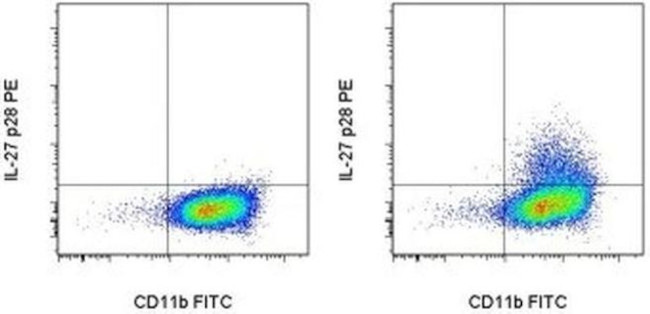Search Thermo Fisher Scientific
Invitrogen
IL-27 p28 Monoclonal Antibody (MM27-7B1), PE, eBioscience™
FIGURE: 1 / 1
IL-27 p28 Antibody (12-7285-80) in Flow

Product Details
12-7285-80
Species Reactivity
Published species
Host/Isotype
Recommended Isotype Control
Class
Type
Clone
Conjugate
Excitation/Emission Max
Form
Concentration
Purification
Storage buffer
Contains
Storage conditions
Shipping conditions
RRID
Product Specific Information
Description: This MM27-7B1 monoclonal antibody reacts with the p28 subunit of Interleukin-27 (IL-27), which is a member of the IL-12 family. IL-27 is a heterodimer of the subunits EBI3 (Epstein-Barr Virus Induced Gene 3), which is homologous to the p40 subunit shared by IL-12 and IL-23, and p28 (IL-30), which is homologous to p35. It is produced by activated dendritic cells and macrophages in response to TLR ligands and inflammatory cytokines.
The IL-27 receptor shares one subunit, gp130, with other members of the IL-6 family. The subunit WSX-1 (IL-27R alpha, TCCR) is unique to IL-27 and is believed to be the only part of the receptor that interacts with the cytokine. The IL-27R is most abundantly expressed on activated T-cells and NK cells, although expression has also been shown on B-cells and naive T-cells. IL-27R activation leads to the phosphorylation of Jak/STAT proteins, with STAT1 and STAT3 being critical to the function of IL-27. IL-27 has been shown to have both pro-inflammatory and anti-inflammatory effects. It influences the commitment of CD4+ T-cells toward the Th1 lineage by inducing the expression of the T-bet transcription factor and the upregulation of IL-12R beta2. Its anti-inflammatory functions include the suppression of Th2 and Th17 proliferation and differentiation. Susceptibility to T-cell mediated autoimmunity has been observed in WSX-1 knockout mice.
Recent evidence suggests that the p28 subunit may also be secreted independently of EBI3 and have functions distinct to the IL-27 heterodimer. It is believed to not only antagonize the activity of IL-27, but also inhibit signaling of other gp130 ligands, such as IL-6 and IL-11.
Applications Reported: This MM27-7B1 antibody has been reported for use in intracellular staining followed by flow cytometric analysis.
Applications Tested: This MM27-7B1 antibody has been tested by intracellular staining and flow cytometric analysis of mouse bone marrow-derived monocytes. This can be used at less than or equal to 0.06 µg per test. A test is defined as the amount (µg) of antibody that will stain a cell sample in a final volume of 100 µL. Cell number should be determined empirically but can range from 10^5 to 10^8 cells/test. It is recommended that the antibody be carefully titrated for optimal performance in the assay of interest.
Excitation: 488-561 nm; Emission: 578 nm; Laser: Blue Laser, Green Laser, Yellow-Green Laser.
Filtration: 0.2 µm post-manufacturing filtered.
Target Information
IL-27, a member of the IL-12 family, is a heterodimeric protein consisting of the p40-related protein Epstein-Barr virus-induced gene 3 (EBI3) non-covalently linked to an IL-12p35-related protein, p28 (also known as IL-30). IL-27 is produced by activated APCs and mature dendritic cells. IL-27 exerts its activities on NK cells and naive CD4+ T cells; mRNA expression analysis of IL-27 receptor components (WSX-1/TCCR and gp130) suggests that IL-27 may also target other cells, including mast cells and monocytes. Binding of IL-27 to WSX-1/gp130 activates JAK1, STAT1, and STAT3 and STAT1/3 phosphorylation. WSX-1/TCCR-deficient mice develop impaired Th1 responses and are more susceptible to infection with L. monocytogenes suggesting that Th1 responses require IL-27. Although activation of WSX-1 is required for the initiation of Th1 responses, it is not necessary for maintaining Th1 responses. IL-27 alone is not able to induce the differentiation of CD4+ T cells into IFN-γ-producing cells, suggesting a role for IL-27 as an initial activator of Th1 responses. An important effect of IL-27 in initiating Th1 responses is the induction of the Th1-specific transcription factor T-bet as well as the suppression of the Th2-specific transcription factor GATA-3. T-bet plays a critical role in Th1 differentiation by its ability to maintain IL-12Rβ2 expression following CD4+ T cell activation. Recent studies indicate that IL-27 has a potent antitumor activity. In vitro, IL-27 has been found to act directly on naive CD8 cells, generating CTL with enhanced granzyme B expression. In vivo, IL-27 has been reported to augment CTL activity, inhibit tumor growth, and induce complete regression of primary and metastatic neuroblastoma tumors.
For Research Use Only. Not for use in diagnostic procedures. Not for resale without express authorization.
How to use the Panel Builder
Watch the video to learn how to use the Invitrogen Flow Cytometry Panel Builder to build your next flow cytometry panel in 5 easy steps.
Bioinformatics
Protein Aliases: IL-27 p28 subunit; IL-27 subunit alpha; IL-27-A; IL-30; IL27-A; ILN; Interleukin; interleukin 30; Interleukin-27 subunit alpha; p28
Gene Aliases: IL-27; IL-27p28; Il27; Il27a; Il30; p28
UniProt ID: (Mouse) Q8K3I6
Entrez Gene ID: (Mouse) 246779

Performance Guarantee
If an Invitrogen™ antibody doesn't perform as described on our website or datasheet,we'll replace the product at no cost to you, or provide you with a credit for a future purchase.*
Learn more
We're here to help
Get expert recommendations for common problems or connect directly with an on staff expert for technical assistance related to applications, equipment and general product use.
Contact tech support

